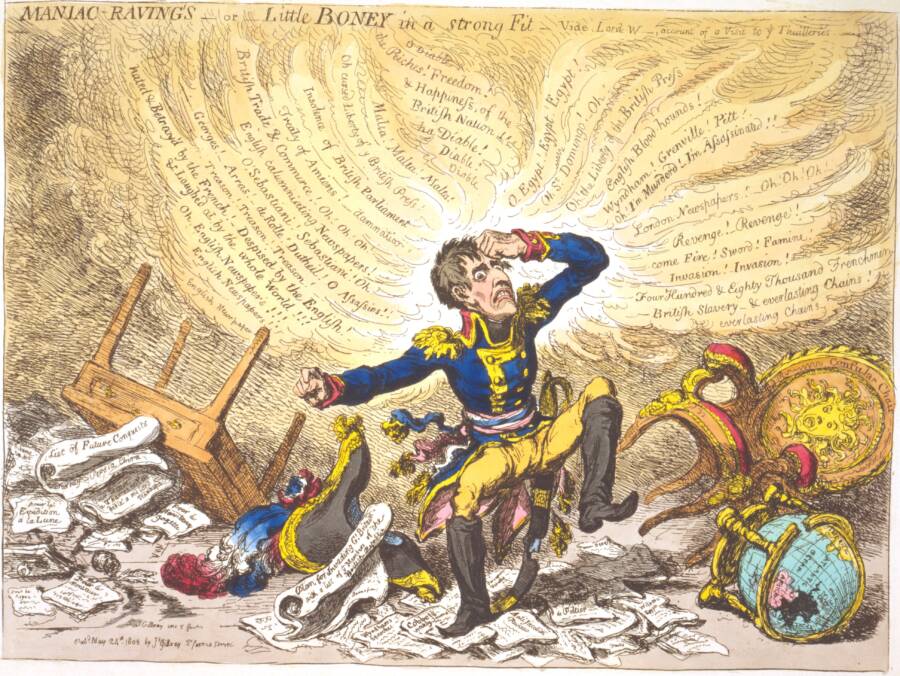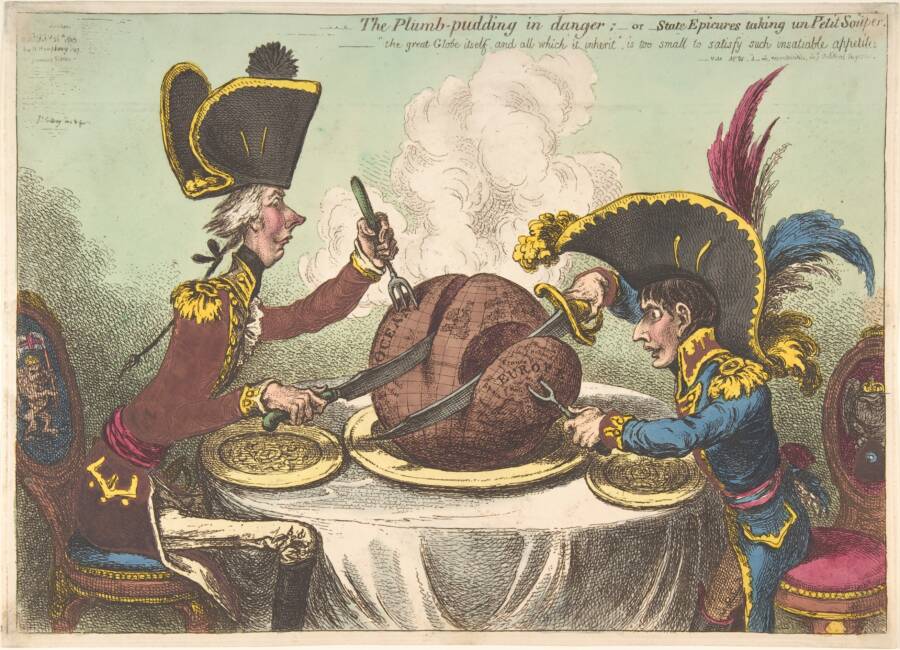Although history remembers Napoleon as an abnormally short ruler, he was actually taller than many Frenchmen of his time — so where did the misconception about Napoleon's height originate?

Wikimedia CommonsDespite the centuries-old misconception, Napoleon Bonaparte’s height was average for his time.
Napoleon Bonaparte is remembered as one of the most notorious leaders in world history. The celebrated general crowned himself emperor of France in 1804 and went on to conquer nearly the entire European continent. Yet today, he is remembered for something else entirely: his supposedly short stature. So just how tall was Napoleon?
Rumors about Napoleon’s height began in the early 1800s when a British cartoonist drew a caricature of the ruler throwing a childlike temper tantrum. His size soon became a running joke in the European press, and the illusion continued to spread from there.
In reality, Napoleon Bonaparte was of average height for a Frenchman in the early 19th century. In fact, he may have even been taller than many of his contemporaries.
So, why does the misconception that Napoleon was short persist today?
Was Napoleon Really Short?

Wikimedia CommonsThe idea that Napoleon was short came about in part due to differences in French and British units of measurement.
One of the main reasons people believe Napoleon Bonaparte was unusually short stems from the discrepancy between French and English inches. During the leader’s lifetime, the French used measurements that predated the metric system and differed slightly from the Imperial measurement system that the British employed.
According to HISTORY, the French inch — called the pouce — was 2.7 centimeters. The Imperial inch was slightly shorter at 2.54 centimeters.
So how tall was Napoleon in French inches? Napoleon’s personal physician noted that he stood just over “5 pieds 2 pouces,” or 5’2″. However, converting this measurement to the Imperial system puts the emperor closer to 5’7″ — which fell at the higher end of average for a Frenchman at the time.
Still, the 5’2″ figure is the one that stuck, leading generations of people to believe Napoleon was exceptionally short.
This difference in units isn’t the sole reason for the misconception surrounding Napoleon Bonaparte’s height, though. The rumor that Napoleon was short spread far and wide during the 19th century because of the British — and one cartoonist in particular.
British Cartoonist James Gillray’s Depiction Of The French Emperor

Wikimedia CommonsJames Gillray’s famous cartoon played a major role in spreading the rumor that Napoleon was short.
During Napoleon’s rise to power, British satirists and cartoonists honed in on the general as a subject of their mockery. Various depictions of the Frenchman appeared in English papers, but one cartoon that supposedly showed how tall Napoleon was became so popular that it influenced many future illustrations.
As historian Tim Clayton, an expert on Napoleonic-era propaganda, told the National Post, the “tiny Napoleon” trope began in earnest in 1803 with the publication of a cartoon titled “Maniac raving’s, or, Little Boney in a strong fit.”
The cartoonist responsible for the portrayal was British caricaturist James Gillray. The image of Napoleon was so popular that it became the norm among British satirists. As Clayton noted, prior to the publication of “Little Boney,” Napoleon “was of normal stature” when depicted in cartoons.
The popularity of “Little Boney” may have stemmed from the fact that it satirized a real diplomatic incident. On March 14, 1803, Napoleon stood before hundreds of European dignitaries at the Tuileries palace in Paris and went on a rage-fueled tirade directed at the British ambassador, Lord Whitworth.
A contemporary account of the incident reads:
“On the appearance of lord Whitworth in the circle, he approached him with equal agitation and ferocity — proceeded to descant in the bitterest terms, on the conduct of the English Government — summoned the ministers of some of the foreign courts, to be the witnesses to this vituperative harangue — and concluded, by expressions of the most angry and menacing hostility… [T]his brutal and ungentlemanly attack… terminated by the first consul [Napoleon] retiring to his apartments, repeating his last phrases, till he had shut himself in; leaving nearly two hundred spectators of this wanton display of arrogant impropriety, in amazement and consternation!”
Gillray’s drawing of this incident depicted a tiny Napoleon stamping his feet on a pile of papers that he tossed onto the floor as he overturned the furniture in his office while ranting about Britain. Once the cartoon of the French leader throwing a childlike tantrum spread, it became the standard for Napoleonic caricatures.
Napoleon’s Response To The Rumors About His Height
Gillray’s portrayal apparently stung Napoleon’s ego quite a bit. At the end of his life, the general even said that the cartoonist’s depiction of him “did more than all the armies of Europe to bring me down.”
The nickname “Little Boney” followed the Frenchman like a pesky bee. Gillray continually portrayed Napoleon as a child-sized man dressed in boots that were far too big for him. He highlighted Napoleon’s temper, often drawing him surrounded by manic, raging thoughts about the British.
Two years after the publication of “Little Boney,” Gillray once again established himself as a master satirist when he created what has been described as “probably the most famous political cartoon of all time.” The cartoon in question was “The Plumb-pudding in danger, or, State epicures taking un petit souper.”

Wikimedia CommonsJames Gillray’s 1805 cartoon “The Plumb-pudding in danger, or, State epicures taking un petit souper.”
The caricature depicts British Prime Minister William Pitt the Younger and Napoleon each carving their own slice of the world. Napoleon is about half the size of his British counterpart and has to stand to cut into the globe, while Pitt has no problem doing so while seated. Napoleon is also carving out a smaller portion of the world.
Significantly, however, although Pitt is shown cutting away a much larger piece of the globe, Napoleon is taking nearly all of Europe for himself — except for Britain and Ireland. In the cartoon, Gillray pokes fun at Napoleon, but he also highlights the very real fears that Brits had about Napoleon’s conquest of continental Europe.
The satirical cartoons were, in a sense, both a way to ease British anxieties over Napoleon’s conquest and a form of fighting back against the autocrat himself. Napoleon even considered the mocking depictions to be a “deliberate provocation.”
In France, Napoleon had effectively stifled the press, ensuring that he would receive nothing but praise in his homeland. However, he couldn’t control what was printed in British newspapers, no matter how hard he tried — and he certainly did try. The emperor once even sent diplomatic messages to Britain demanding that the government censor the cartoons, but the ministers simply ignored him.
Napoleon had a vision of himself as a “great man” of history, writing, “Even when I am gone, I shall remain in people’s minds the star of their rights.”
Of course, his defeat at the battle of Waterloo and subsequent exile put an end to his grand ambitions. Despite it all, the portrayal of “tiny Napoleon” continued long after the leader’s death — and the term “Napoleon Complex” is still used to refer to people who overcompensate for their short stature with an aggressive personality.
After learning the truth about Napoleon’s height and how tall Napoleon was, discover how tall Jesus was, according to researchers. Or, read about the origins of the phrase “let them eat cake” and how it came to be attributed to Marie Antoinette.





